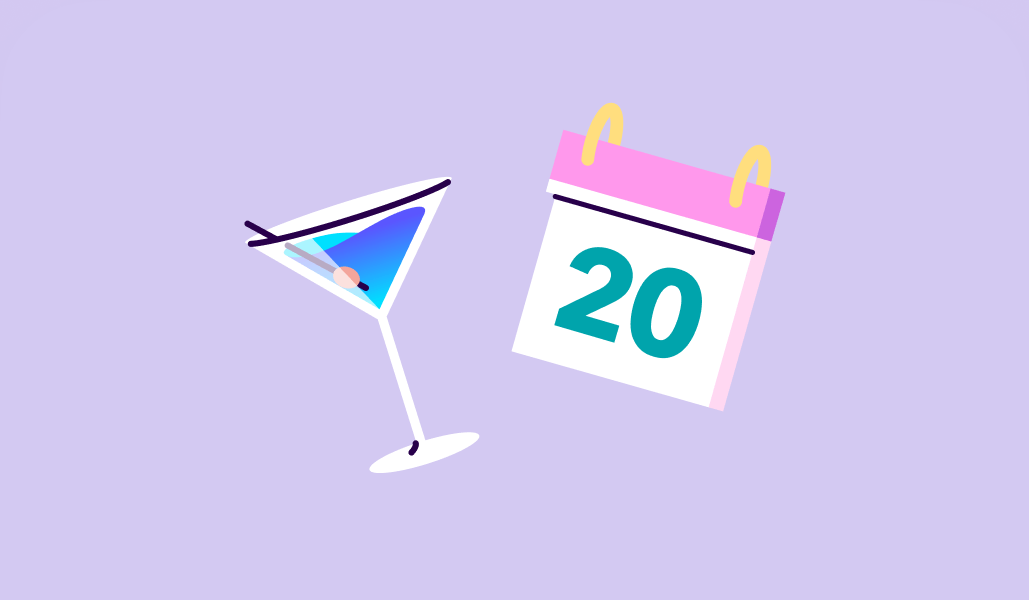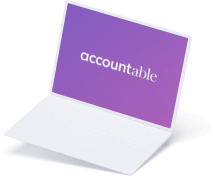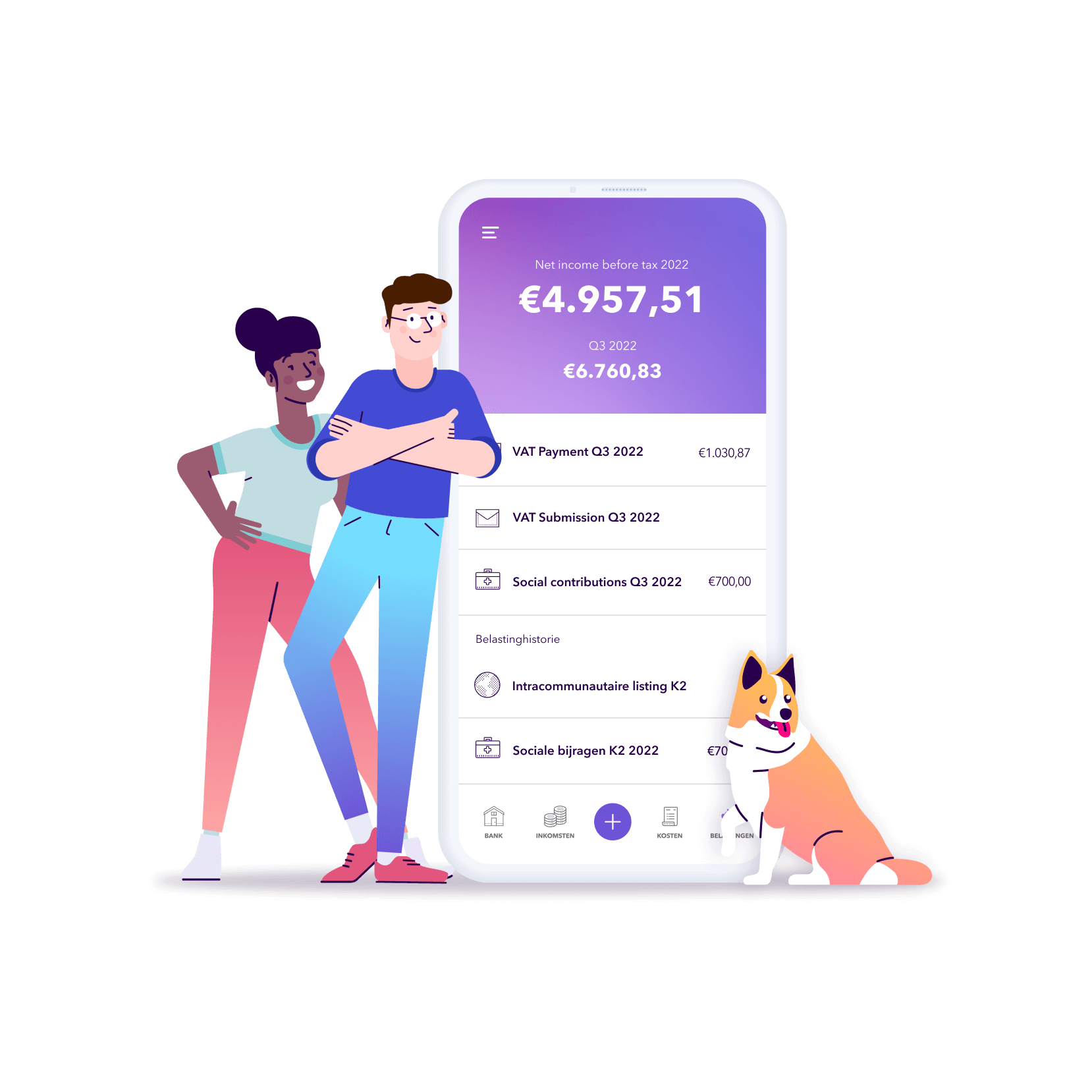
Managing VAT as a self-employed made easy 💪🏼
Read in 5 minutes
Let’s start by the beginning: what does VAT stand for?
Knowing what VAT stands for is probably the easiest part 🙂: VAT stands for Value Added Tax and is the tax that every consumer pays when buying goods or services.
VAT applies to most commercial transactions and as a result, it is a major source of income for Belgium. The government, of course, wants that system to run as smoothly as possible.
Your clients will also pay a VAT, when they buy a product or service from you. As a supplier, you collect this tax from your clients and you transfer the amount back to the government.
Basically, in what regards VAT, you are an intermediary between the state and the end-consumer.
The percentage of this tax depends on what kind of goods or services you are selling and how necessary they are to the consumer.
- 6%, for basic necessities; the things that every person needs, products such as books, pharmaceuticals, water, milk and milk products, live animals and meat, services such as passenger transport, etc.
- 12%, for goods and services that are of social or economic interest. This ranges from margarine to a TV subscription as well as caterers and catering services (drinks and the supply of prepared meals not included)
- 21%, for anything not covered with the 6% and 12% rate
When selling goods or services, you should know and apply the right VAT rate to your prices.
Through your VAT returns and the associated payments, the government knows exactly how much it is due and when to get it.
Filing VAT creates a genuine administrative burden for self-employed: before crying for support, let’s quickly review who is exempt from this duty.
So, who should not file VAT returns 😎?
- Specific professions
Certain liberal professions that focus on assistance for individuals are not subject to VAT. As a result, they also do not have a VAT number. For example, doctors, physiotherapists, and help at home, are part of this category.
- If you choose a VAT exemption arrangement
Good (belated) news! Since January 2016, if your annual turnover is below 25,000 euros, you can opt for the VAT exemption scheme 👍
The advantage of this system? You are no more bothered with VAT returns.
You drop VAT from your invoices, making you directly more affordable for customers that don’t recover VAT and easing the cash-flows of all others.
The drawback? Dropping VAT also means that you can not get the VAT back on your purchases.
Once your annual turnover is higher than 25,000 euros, don’t forget to adjust to the VAT system (and notify your customers as well).
Pay attention!
- Even if you are exempt from VAT filings, you still have to activate your enterprise/VAT number.
- You also have to submit a list of all your customers before the 31st of March (here in Dutch and here in French, sorry no English) of every year after the moment you receive a VAT number. Please note that you can exclude from this list (i) customers that don’t have a Belgian VAT number and/or (ii) customer with whom you have less than 250 euros turnover per year
- Make sure to check if your profession can be exempted from VAT. In certain professions (the real estate sector, preparation of meals, delivery of recovered materials) this is not possible.
Do you meet all of these conditions?
Here is how you can opt for the VAT exemption scheme:
- If you want to opt for the VAT exemption scheme for a given year, you must absolutely apply for it to the inspection department by 15th December of the preceding year at the latest.
- If you start as a self-employed person under the VAT exemption scheme, you must estimate your turnover in your application for identification for VAT purposes at the start of your activity (form 604A). This amount is compared with the 25,000 euros that are a central element in the VAT exemption scheme
How to submit your VAT declaration ✍🏻?
If you are subject to VAT, you have to submit your VAT returns and make the corresponding payments.
No worries though, we’re here to help. Just for you, here is a quick guide to filing VAT in Belgium:
Let’s start at the beginning: in general, you’re receiving VAT on everything that you sell and you’re paying VAT on everything that you buy. The difference between the two goes into the treasury of the state. You’re communicating this amount via your VAT return to the Ministry of Finance.
To submit your VAT return, you have to go to the website of Intervat. Small pro tip: keep your identity card, your PIN code and your card reader at hand. You will need them before you can start.
The government has issued a short tutorial to help you through the process, in French and in Dutch (best to open either of them on your desktop since they are not really mobile friendly).
In general, the steps to follow (in Dutch) are > “Welkomstpagina / Verzending via scherm / Nieuw / Periodieke btw aangifte.
From here you need to follow the guide, screen by screen. Make sure you understand everything and don’t make any mistakes while submitting your VAT information. For English speakers, don’t hesitate to ask a Dutch speaking or French-speaking friend to guide you through the process!
Remember that the government is very strict and imposes penalties on infringement, so be sure to not get distracted while doing this… or maybe let your accountant (or Accountable) do this for you.
When do you need to file your VAT declaration ⏰?
It all depends… Your annual turnover is
- above 2.500.000 euros (excl. VAT ): you’ve got to file your VAT every month, plus the payment of this VAT to the government needs to happen at the latest on the 20th of the following month.
- below 2.500.000 euros (excl. VAT): you can file your VAT every three months and the payment of this VAT to the government needs to happen at the latest on the 20th of the month following when you filed your VAT. Watch out, in December you have to pay an advance on the taxes based on your activities of the fourth trimester.
The Ministry of Finance made a calendar with all the different payment and return periods.
Some professions that do not send a lot of invoices (think of butchers, bakers, small business owners, hairdressers, etc.) and whose turnover does not exceed 750,000 euros can opt for a lump sum VAT scheme.
Last tips before leaving 👇
- Do not forget to update your annual client listing.
As stated earlier you have to send in a list of all your taxable customers on the 31st of March, every year. You can do this via Intervat, and the tutorial on how to do this is located here, follow “Welkomstpagina / Verzending via scherm / Nieuw / Klantenlisting”
- Don’t forget to send in your intracommunity listing(s)
This is the list of all (trans)actions your company did for VAT identified customers in other EU countries. You need to send in this list every three months (if you file your VAT every three months) or every month (if you file your VAT every month).
How? Intervat of course 😎, following the same tutorial as with your annual list of taxable customers.
What happens if my VAT status changes 🕺?
A. You start as self-employed and you want to register for a VAT number?
You have to fill in form 604A with the correct type of business you want to start. Not feeling comfortable enough to do it by yourself? You can also do this with at a registered business counter or with an accountant (these options are probably not free). Your VAT number is the same as your company number, with BE in front of it.
B. I want to change something about my activities as self-employed
You want to change things like your address, or the name of your business? In this case, you need to submit a form 604B to update your status at the Administration in the month following those changes.
C. I want to end my self-employed business
Sure thing, there is also a form for that one: form 604C is the one you’re looking for in this case. Don’t forget to submit it to the Administration following the month that you stop your activities that are subject to VAT.
Does it still sound too complex? Too expensive? No worries, we got you covered!
Accountable is a mobile application that connects to your professional bank account and automates the biggest part of all your financial administration. When you purchase or sell something, all you have to do is take a picture of the receipt or invoice and validate the suggestions the app provides to you.
What has your biggest frustration with VAT filing been over the years? Or has everything been a smooth ride up until now? Let us know in the comments below!
Did you find what you were looking for?
Happy to hear!
Stay in the know! Leave your email to get notified about updates and our latest tips for freelancers like you.
We’re sorry to hear that.
Can you specify why this article wasn’t helpful for you?
Thank you for your response. 💜
We value your feedback and will use it to optimise our content.






